The heat-inducible transcription factor HsfA2 enhances anoxia tolerance in Arabidopsis
- PMID: 20089772
- PMCID: PMC2832282
- DOI: 10.1104/pp.109.149815
The heat-inducible transcription factor HsfA2 enhances anoxia tolerance in Arabidopsis
Abstract
Anoxia induces several heat shock proteins, and a mild heat pretreatment can acclimatize Arabidopsis (Arabidopsis thaliana) seedlings to subsequent anoxic treatment. In this study, we analyzed the response of Arabidopsis seedlings to anoxia, heat, and combined heat + anoxia stress. A significant overlap between the anoxic and the heat responses was observed by whole-genome microarray analysis. Among the transcription factors induced by both heat and anoxia, the heat shock factor A2 (HsfA2), known to be involved in Arabidopsis acclimation to heat and to other abiotic stresses, was strongly induced by anoxia. Heat-dependent acclimation to anoxia is lost in an HsfA2 knockout mutant (hsfa2) as well as in a double mutant for the constitutively expressed HsfA1a/HsfA1b (hsfA1a/1b), indicating that these three heat shock factors cooperate to confer anoxia tolerance. Arabidopsis seedlings that overexpress HsfA2 showed an increased expression of several known targets of this transcription factor and were markedly more tolerant to anoxia as well as to submergence. Anoxia failed to induce HsfA2 target proteins in wild-type seedlings, while overexpression of HsfA2 resulted in the production of HsfA2 targets under anoxia, correlating well with the low anoxia tolerance experiments. These results indicate that there is a considerable overlap between the molecular mechanisms of heat and anoxia tolerance and that HsfA2 is a player in these mechanisms.
Figures
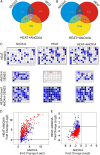
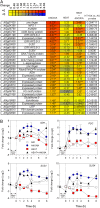
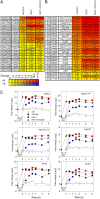

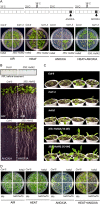
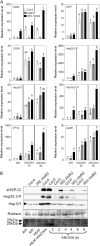
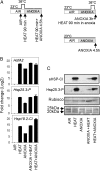
Similar articles
-
Promoter specificity and interactions between early and late Arabidopsis heat shock factors.Plant Mol Biol. 2010 Jul;73(4-5):559-67. doi: 10.1007/s11103-010-9643-2. Epub 2010 May 11. Plant Mol Biol. 2010. PMID: 20458611 Free PMC article.
-
HsfA1d and HsfA1e involved in the transcriptional regulation of HsfA2 function as key regulators for the Hsf signaling network in response to environmental stress.Plant Cell Physiol. 2011 May;52(5):933-45. doi: 10.1093/pcp/pcr045. Epub 2011 Apr 6. Plant Cell Physiol. 2011. PMID: 21471117
-
A heat-inducible transcription factor, HsfA2, is required for extension of acquired thermotolerance in Arabidopsis.Plant Physiol. 2007 Jan;143(1):251-62. doi: 10.1104/pp.106.091322. Epub 2006 Nov 3. Plant Physiol. 2007. PMID: 17085506 Free PMC article.
-
HSFA2 orchestrates transcriptional dynamics after heat stress in Arabidopsis thaliana.Transcription. 2016 Aug 7;7(4):111-4. doi: 10.1080/21541264.2016.1187550. Epub 2016 Jul 6. Transcription. 2016. PMID: 27383578 Free PMC article. Review.
-
ROS signaling as common element in low oxygen and heat stresses.Plant Physiol Biochem. 2012 Oct;59:3-10. doi: 10.1016/j.plaphy.2012.02.016. Epub 2012 Mar 3. Plant Physiol Biochem. 2012. PMID: 22417734 Review.
Cited by
-
A Genome-Wide Analysis and Expression Profile of Heat Shock Transcription Factor (Hsf) Gene Family in Rhododendron simsii.Plants (Basel). 2023 Nov 20;12(22):3917. doi: 10.3390/plants12223917. Plants (Basel). 2023. PMID: 38005814 Free PMC article.
-
The Heat Stress Factor HSFA6b Connects ABA Signaling and ABA-Mediated Heat Responses.Plant Physiol. 2016 Oct;172(2):1182-1199. doi: 10.1104/pp.16.00860. Epub 2016 Aug 4. Plant Physiol. 2016. PMID: 27493213 Free PMC article.
-
Molecular and physiological responses in roots of two full-sib poplars uncover mechanisms that contribute to differences in partial submergence tolerance.Sci Rep. 2018 Aug 27;8(1):12829. doi: 10.1038/s41598-018-30821-y. Sci Rep. 2018. PMID: 30150759 Free PMC article.
-
HEAT-INDUCED TAS1 TARGET1 Mediates Thermotolerance via HEAT STRESS TRANSCRIPTION FACTOR A1a-Directed Pathways in Arabidopsis.Plant Cell. 2014 Apr;26(4):1764-1780. doi: 10.1105/tpc.114.124883. Epub 2014 Apr 11. Plant Cell. 2014. PMID: 24728648 Free PMC article.
-
Proteomic analysis of broccoli (Brassica oleracea) under high temperature and waterlogging stresses.Bot Stud. 2015 Dec;56(1):18. doi: 10.1186/s40529-015-0098-2. Epub 2015 Jul 15. Bot Stud. 2015. PMID: 28510827 Free PMC article.
References
-
- Bailey-Serres J, Voesenek LA. (2008) Flooding stress: acclimations and genetic diversity. Annu Rev Plant Biol 59: 313–339 - PubMed
-
- Banti V, Loreti E, Novi G, Santaniello A, Alpi A, Perata P. (2008) Heat acclimation and cross-tolerance against anoxia in Arabidopsis. Plant Cell Environ 31: 1029–1037 - PubMed
-
- Bieniawska Z, Barratt DHP, Garlick AP, Thole V, Kruger NJ, Martin C, Zrenner R, Smith AM. (2007) Analysis of the sucrose synthase gene family in Arabidopsis. Plant J 49: 810–828 - PubMed
MeSH terms
Substances
LinkOut - more resources
Full Text Sources
Molecular Biology Databases

